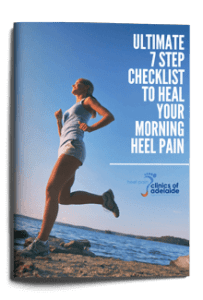Achilles Tendinitis Treatment Adelaide
Do you wake up limping in the morning?
- Is your Achilles stiff in the morning getting out of bed?
- When playing sport or exercising, is it sore when you warm up or cool down?
- Does it ache at the end of the day following a big day on your feet?
- Is there a swollen or thickened lump in the Achilles tendon or behind the heel?

Achilles pain is our second most common injury we see at Adelaide Heel Pain Clinics. At our specialist clinic we see 25 cases per day of this injury commonly labelled Achilles Tendinitis or Tendinopathy. We have a special focus in diagnosing and treating this condition, and our niche are cases that have been chronic and difficult to fix. We have found we are either the first professionals people see for plantar fasciitis, or the one after they have seen multiple health professionals like GPs, podiatrists, physios and surgeons.
The condition labelled Achilles Tendonitis or Achilles Tendinopathy can be a serious problem for you. It’s a nasty condition and one that needs to be treated fast once it presents itself or ideally prevented in the first place. Studies have found that when the injury enters its 6th month the texture of the Achilles Tendon has profoundly altered and making the tendon pain free is more difficult and will take much longer.
Adelaide Heel Pain Clinic proudly offers quality Achilles Tendonitis treatment to residents of North Adelaide, Eastwood, Parkside, Glenside, Frewville, Fullarton, Highgate, Myrtle Bank, Brompton, Prospect, Walkerville, Unley, St Peters, Norwood, Thebarton, Mile End, Glenunga, and surrounding suburbs.
Symptoms of Achilles Tendonitis
Achilles tendonitis is characterised by a set of distinct symptoms that are important to recognise for early intervention. One of the primary signs of the condition is a stiff ache in the Achilles tendon area, especially noticeable when getting out of bed. This stiffness is also often present during warm-up and cool-down phases of exercise routines, signaling an underlying issue with the tendon. As the day progresses, individuals with Achilles tendonitis typically experience an intensifying ache, which becomes more pronounced towards the evening. Another potential symptom is the presence of a swollen or thickened lump on the Achilles tendon which may indicate painful inflammation, swelling or aggravation in the tendon area.
Causes of Achilles Tendonitis
Achilles tendonitis often arises from a combination of factors related to foot function, footwear, muscle condition, and physical activity. One of the primary causes is poorly functioning feet, particularly the flattening of the arch, which can place excessive strain on the Achilles tendon. This strain is exacerbated when coupled with the use of poor or soft footwear that fails to provide adequate support and stability to the foot and ankle.
Additionally, tight calf muscles contribute significantly to the development of Achilles tendonitis. When calf muscles are tight, they increase the tension on the Achilles tendon, making it more prone to injury, especially during physical activities. This risk is further heightened when there’s a sudden increase in sporting activity, particularly if accompanied by poor training methods or techniques. Such increases can overburden the tendon, especially if the body is not adequately conditioned or accustomed to the new level of activity, leading to inflammation and pain in the Achilles tendon.
Treatment for Achilles Tendonitis
The treatment of Achilles tendonitis involves a multifaceted approach, focusing on both alleviating immediate discomfort and addressing underlying causes. Key elements of this treatment include Achilles stretching, strengthening exercises, and icing. These activities help in reducing inflammation, improving flexibility, and strengthening the tendon and surrounding muscles, thereby aiding in pain relief and preventing further injury.
Additionally, radial shockwave therapy has emerged as an effective treatment option, offering pain relief and promoting healing by stimulating the affected area. Addressing biomechanics is also crucial; this involves selecting appropriate footwear or using orthotics to provide better support and alignment, reducing strain on the Achilles tendon. Training modification is essential, especially for athletes and active individuals. This includes adjusting exercise routines and techniques to avoid overstraining the tendon, allowing for gradual and safe increases in activity levels while the tendon heals.
Gap Free Heel Pain Assessments*
We offer a GAP FREE ASSESSMENT* for heel pain under your health insurance.
Achilles Pain
The Three Types of Achilles Pain
Why is my Achilles stiffer in the morning?

Ultimate 7 Step Checklist to Heal Your Morning Heel Pain

Ultimate 7 Step Checklist to Heal Your Morning Heel Pain

Book Online in less than 60 Seconds
Join over 20,000 South Australians who are now pain free!
